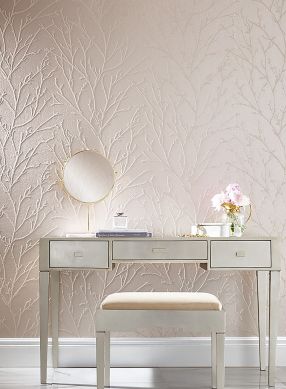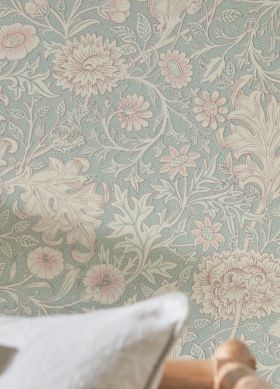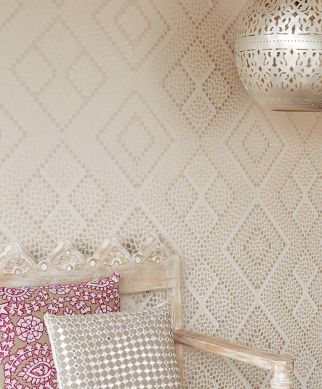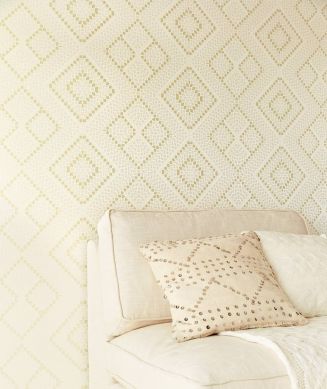Glass bead Wallpaper
Glass bead wallpaper: The Guide
Glass bead wallpaper stands for pure luxury, unconventional extravagance, they are testimony to an exquisite and sophisticated taste. Innumerable glass beads and glass crystals sparkle and let the room shine with unique brilliance. They appear three-dimensional and majestic, but can also boast a discreet sophistication. The high quality of these exclusive wallpapers paired with classical or modern patterns in a wide range of colours is truly eye-catching.
Table of Contents
- What is glass bead wallpaper?
- How is the shimmering and sparkling effect of glass bead wallpaper created?
- What types of beads are used for wallpaper?
- In which different ways are the glass beads arranged on wallpaper?
- How are the glass bead colours arranged in relation to the basic colour of the wallpaper?
- What does the wallpaper surface on which the glass beads stick consist of?
- What are the most popular colours for wallpapers with glass beads?
- Which pattern motifs are frequently depicted on glass bead wallpaper?
- What should be considered when applying glass beads wallpaper?
- How and to what extent can glass beads wallpaper be cleaned?
- Can bits of glass beads that have come off be reattached to the wallpaper?
- Our tips: Design and decoration ideas for glass beads wallpaper
What is glass bead wallpaper?
Glass bead wallpapers have a carrier layer of paper or non-woven material. The glass beads are applied using a special technique that also allows for three-dimensional patterns.
Paper-based or non-woven wallpaper as carrier material
If the carrier material consists of paper, adhesive paste is applied to the pre-cut lengths of wallpaper which then require a soaking time of a few minutes before hanging. If the carrier layer is made of a non-woven material (cellulose and textile fibres), the paste is applied to the wall and the pre-cut lengths are put up directly. Small cracks in the wall surface can be concealed by the non-woven material.
Glass beads are applied with a special adhesive technique
Glass beads are applied by hand or machine with adhesive which is suitable for the surface, using a special gluing technique. Particularly delicate motifs and pattern silhouettes require the skilful application of the glass beads by experienced specialists. This makes each roll a unique luxury object.
Three-dimensional patterns
By refining the wallpaper surface with glass beads and crystals, fascinating three-dimensional patterns are created. High-low structures and a tactile relief make these luxurious wallpapers a visual and haptic pleasure. Touching is allowed, but the fact that the special material composition is delicate must always be taken into account.
How is the shimmering and sparkling effect of glass bead wallpaper created?
Light is refracted in each individual bead, and light reflections create sparkling effects. Their colour nuances change with the incidence of light, and both daylight and direct artificial lighting conjure up different effects.
Refraction of the light in each bead
Light is absorbed and refracted by each individual glass bead. Thousands of small crystals or beads are glued to the wallpaper to create a fascinating sparkle which attracts the eye. Patterns seem to move subtly and in surprising ways. Depending on the angle of view, the glass beads appear bright and shiny or dark and mysterious.
Reflections of light in the glass
When light is reflected in the glass beads, the room is bathed in beautiful luminosity and majestic brilliance. Like rays of sunshine, the beads flash along the patterns, the pattern outlines or across the entire surface. This effect can be enjoyed with all senses. It is unique in the wallpaper world and cannot be compared to any other material.
Changing colour nuances depending on the incidence of light
Both transparent as well as coloured/stained glass beads or glass crystals are used on wallpaper. In transparent beads, the incidence of light changes the colour nuances which are based solely on the light spectrum. In the case of coloured glass beads, this effect is even more attractive and can have a gorgeous rainbow effect.
Daylight or directly artificial light
Daylight makes glass beads shine just as brightly as direct lighting from lamps. The difference is in the angle at which the light hits the beads. As the sun moves during the day, different areas of wallpaper are highlighted. With direct lighting, the shimmering effect unfolds on the areas that are illuminated by the lamp.
What types of beads are used for wallpaper?
In terms of the surface of sparkling wallpapers, there are three main types of potential materials: glass beads, glass crystals and plastic beads.
Glass beads
Transparent or dyed glass beads are amongst the oldest pieces of jewellery known to man. There are various techniques and processes for making them, both by hand and by machine. The luxury version is made of Murano glass. Glass beads can also be silver-plated or coated with gold on the inside.
Glass Crystals
Glass crystals are cut glass beads. They are characterised by facets that refract the light in a thousand dimensions and colours. The facets can be cut or pressed. Different sizes and shapes can be produced, including prisms, discs, spheres or motif-related crystals. In bead-form they are called crystal beads.
Plastic beads
Visually, pearls made of plastic cannot be distinguished from glass; they can only be recognised by their lower weight. Their surface is slightly smoother, which is why they reflect and refract light more diffusely. Due to lower manufacturing costs, design wallpapers can be adorned with plastic beads across the entire surface and in a wide range of colours.
In which different ways are the glass beads arranged on wallpaper?
Patterns can be outlined with beads, or motifs can be completely filled in. Applying the beads across the entire surface (i.e. regardless of the pattern) is an option that creates iridescent shine.
Pattern outlined with beads
If the pattern silhouettes are decorated with beads, the pattern itself is emphasised, and movement is created. Geometric pattern designs are particularly well suited for interesting three-dimensional effects. Baroque-style or damask wallpapers or floral patterns studded with glass beads provide magical highlights.
Motifs filled with beads
Brilliant contrasts and three-dimensional structures are created when the pattern is entirely covered with beads and the background is matt. Depending on how closely the pattern elements are arranged, brilliant flashes of light can be the surprising result.
Applying the beads independent of the pattern across the entire surface
The application of glass beads and glass crystals on the entire wallpaper surface creates a uniform light effect that is hard to beat in terms of radiance and luminosity. Natural or artificial light changes the shine and brightness in tonal nuances. Ideal for rooms that are meant to exude glamorous luxury.
How are the glass bead colours arranged in relation to the basic colour of the wallpaper?
The glass beads can be combined in harmonious colours. Tone-in-tone effects are achieved by using transparent, translucent beads. Beads in colours contrasting the base colour also have an impressively attractive effect.
Glass beads in harmonious colours
Complementary colours have a harmonious effect on the human eye. These are the colours that are opposite each other in the chromatic circle such as purple and yellow, blue and orange. Colours that are directly next to each other in the chromatic circle, such as green and yellow or red and orange, also work together well. Brighter shades as well as white, grey and black harmonise with many other colours.
Transparent, translucent beads
Transparent glass beads let the base colour shine through and give the wallpaper a tone-in-tone effect. This is particularly effective when the colour is given a bit of a sparkle. The effect works with both light and dark colours.
Beads colour contrasting the base colour
Among the achromatic colours, black and white provide the strongest contrast. For primary colours, it is red, yellow and blue. There is also the cold-warm contrast or the complementary contrast. In all those cases, the colour differences of contrasting glass beads are much more noticeable to the eye, giving the pattern its own dynamic.
What does the wallpaper surface on which the glass beads stick consist of?
The pattern or motif background is either covered with glitter paint or is varnished in a colour that either matches or contrasts it. Matt backgrounds result in structural differences that can be seen and felt.
Glitter paint background
Glimmer and glitter background colours subtly enhance the lustre of the light, emphasising the luxurious aspect of glass bead wallpapers. They are usually in similar or matching colours so that the eye is not overwhelmed.
Varnished or lacquered background
A lacquered background creates a subtle shine that enhances the sparkle of the glass beads. The lacquered surface gives the wallpaper a touch of sophistication and also reflects the light, which in combination with the sparkling crystal beads opens up new, fiery perspectives.
Matt background colour
Matt background colours provide matt-gloss and structural contrasts. The glass bead wallpaper becomes a visual and tactile experience, with charming contrasts magically attracting the eye. Relief patterns also appear even more 3D.
What are the most popular colours for wallpapers with glass beads?
Wallpapers with glass beads can come in natural, pastel, intense or metallic colours. Grey, gold, silver, white and rosé are popular as these colours emphasise the distinctive character of the light-reflecting beads.
Grey
This neutral colour is subtle, bringing out the brilliant shine of the glass beads. Grey is modern and straight-forward, it symbolises stability and reliability. Almost any other pattern or bead colour is more effective when paired with grey. In combination with silver, the pearlescent lustre is intensified.
Gold
Gold, the colour of the sun, stands for strength, power and splendour. Its brilliance is unsurpassed, which is why glass beads or glass crystals are the crowning glory of this majestic colour. Gold works well with dark brown hues, but is also very popular on its own. Transparent glass beads create harmonious tone-in-tone effects.
Silver
Silver stands for cool elegance, modernity and individuality. Silver reflects other colours and appears very pure and clear. It can be combined with just about any other colour and has an illuminating, fresh effect. Silver-plated glass beads add extravagance. Wallpapers fully covered with silver beads appear like the backdrop to a scene from a space movie.
White
In glass bead wallpapers, the colour of purity, clarity and freshness is found in both cool and warm nuances. It has a magical and elegant aura and its light spectrum contains almost all colours, making it perfect for glass bead wallpaper.
Rosé
This combination of red and white offers delightful nuances from powder rosé to light copper rosé and is given an aristocratic touch by glass elements. In combination with countless glass beads, this colour is the perfect way to celebrate a luxurious and romantic lifestyle.
Which pattern motifs are frequently depicted on glass bead wallpaper?
Generally speaking, any pattern motif can be enhanced by glass beads. Stripes, baroque ornaments, filigree floral tendrils and graphic patterns rank high on the popularity scale.
Stripes
The classic stripe pattern, be it horizontal, vertical or diagonal, is given a touch of exquisite elegance by the addition of glass beads. It represents understated luxury, especially when the beads frame the stripe silhouette with thin lines. If the stripes are completely covered with glass beads, a multidimensional look is created.
Baroque ornaments
Glass beads and the baroque style work together in perfect harmony. The era of splendid interiors was exceedingly fond of the sun's scintillating shine, which to this day is perfectly captured with glass crystals. Bright purple-red, royal blue, sapphire green, gold and ivory are the wallpaper or bead colours that inspire the most dazzling design concepts.
Filigree floral tendrils
The beauty of delicate floral tendrils can be intensified with glass beads. Charming cream colours are a firm favourite for sophisticated glass bead wallpapers, closely followed by silver and white. Glass beads in a floral style combine romanticism and noblesse and are extremely well suited for the upscale country house style, to name just one example.
Graphic patterns
Graphic patterns decorated with glass beads are trendy and unconventional. They characterise modern glamour which is inspired by iconic locations such as the legendary Studio 54 in New York. Reflecting an exuberant party feeling, they conjure up a zest for life in the room.
What should be considered when applying glass beads wallpaper?
The most important prerequisite for hanging these kinds of wallpaper is sufficient time. In addition, a sharp cutting knife and soft tools are essential. Work with clean hands and apply as little pressure as possible whilst avoiding paste stains on the surface.
Sharp cutting knife
Sharp cutting tools are required for cutting the lengths of glass beads wallpaper to size and for trimming it on the wall (ceiling/floor), along door frames, radiators or windows. Smooth and precise cutting knives are necessary to prevent the glass beads from being damaged or peeling off.
Work with little pressure
A soft, lint-free cloth should be used to gently press the wallpaper on the wall. Work slowly, length by length, and with as little pressure as possible from top to bottom and from left to right. A cautious approach is required when smoothing out air pockets.
Make sure that your hands are clean
Thin cotton gloves are particularly well suited to protect the sensitive wallpaper surface from staining and damage during the wallpapering (smoothing and pressing-on) process. It is important to ensure that the wallpapering paste does not damage the wallpaper surface. Gloves should be cleaned or replaced when stained.
Avoid paste stains
The best approach is to avoid paste stains from the outset. If it does happen, the paste stains should immediately be dabbed off with a slightly damp, lint-free cloth (NO rubbing). When drying, the paste creates an unsightly stain which makes the pearls appear dull and impairs the light effect.
Choose soft tools
A PU foam seam roller is the first choice when it comes to pressing down the seams. However, if there are any glass beads directly at the seams, hands in cotton gloves are the better solution. It's best to use the tools that expose the glass beads to the least pressure.
Take your time
Cutting and hanging the wallpaper takes time. This work requires concentration and care and unnecessary time pressure won't help. This is especially important if you hire professionals to put up your wallpaper. These experts are used to working fast which can lead to problems and damage when it comes to delicate glass bead wallpapers.
How and to what extent can glass beads wallpaper be cleaned?
A classic feather duster is the best tool to remove dust from wallpapers with glass beads. Small stains can be removed carefully with a damp cloth from all models that are marked as washable.
Carefully dab off stains
Clearly visible stains can be carefully dabbed off with a damp cloth which has been dipped in mild soapy water and wrung out thoroughly. Friction must be avoided at all costs. The adhesive bond between the beads and the wallpaper surface should not be exposed to too much liquid, otherwise the adhesive may soften and the beads may fall off.
Remove dust with a classic feather duster
Dust and deposits from the air can be removed gently with a conventional feather duster. Windows should be wide open during this process so that the dust can immediately move outside. Never use a vacuum cleaner for this process!
Can bits of glass beads that have come off be reattached to the wallpaper?
From time to time, glass beads may fall off, e.g. if they are damaged by impact when moving furniture. In those cases, delicate manual work with glue and tweezers is required.
Apply glue to wallpaper with a needle point
A needle is a suitable tool to reapply beads to wallpaper. Dip the tip of the needle into the glue (all-purpose glue or super-glue) and brush it off on the part of the wallpaper where beads are missing. Proceed slowly so that surrounding areas do not come into contact with the glue.
Use tweezers to place the bead on the glue
Use a thin pair of tweezers to pick up each bead and place it on the glue. Then press the bead down carefully with your finger. Depending on the adhesive used and its properties, the bead will stick to the wallpaper immediately or require a few hours to dry.
Our tips: Design and decoration ideas for glass beads wallpaper
- Room dividers as fantastic eye-catchers: Open room dividers or long screens are turned into an attractive highlight when decorated on both sides with a sparkling glass bead wallpaper. The colours should match the rest of the wall design and the furnishings.
- Design your own silver crystal room: In silver rooms, the level of artistic creativity increases, as Andy Warhol aptly proved with his "Silver Factory". Tone-in-tone effects with a shimmering silver base colour and transparent glass beads or sparkly effects with tiny shards of glass give free rein to futuristic ideas.
- Glamorous exoticism for the staircase: For a glamorous design, choose a wall in the stairway that immediately catches the eye upon entry. Decorate it with a botanic pattern glass bead wallpaper, for instance an exotic palm motif in contrasting colours. This creates a timeless and sophisticated ambience in the sought-after Art Deco or Gatsby-style.
- Modern Glitter Art in girls' rooms: White-rosé is the perfect basic shade for a lovely wallpaper with small glass beads which form a diamond pattern. Girls who can't get enough of glitter and glamour will love this wall design behind the headboard of the bed or the dressing table.















































